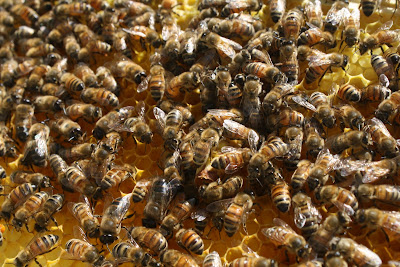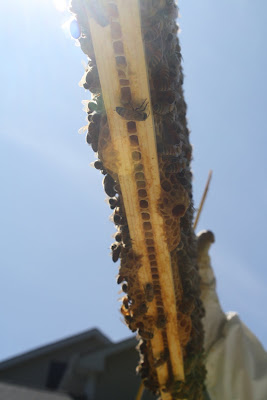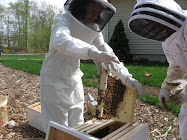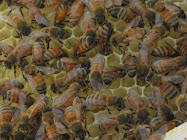Here is a picture of my hives: "The Right" and "The Left". The Left hive, it seems, has swarmed. Although oddly enough, my brother's family is staying at our house for the summer and no one saw them leave even though the hives are situated just to the right side of my garage. Is it possible I had a weak / failing queen and missed the signs? Small number of eggs, larvae and capped brood? I don't know. But, they did make queen cells, and my brother took pictures for you.

In the center of this picture -- slightly to the lower right -- is a queen cell. I found queen cells both on the bottom of one frame, build into the comb on another frame, and on the side of the comb on another frame. One of my "bee teachers" stressed to me recently that bees are just insects, so they don't always "follow the rules" making queen cells IN the comb which are generally "supercedure" cells when you have a failing, weak or dead queen -- even though they are technically being used for swarm cells. Which is when they feel crowded and decide to split off and 50% of the bees leave with the existing queen and create queen cells to produce a new queen for the remaining bees that stay behind.
The frustrating thing is, I may have missed the "signs" of a failing or weak queen, but the one thing I know I paid strict attention to is room in the hive. This hive was never short on room, but for some reason, it appears that they felt the need to leave. I don't know, it's a mystery.

This is a bad photo, but you can see a queen cell at the bottom of the frame.

Another view.
There were a few more queen cells the last time we went in two days before. The bees must have cleaned them off.

Here is a queen cell built into the comb on the side near the frame.
I do remember seeing some unusual comb being built in this hive, but I thought it was drone comb, which is shaped a bit like the puffy end of a piece of popcorn. Next time, I'll take any weird stuff off.

My brother and I looked through the entire brood chamber and didn't find a Virgin Queen. They are very difficult to spot because they haven't mated yet, so their abdomen (the most distinguishing feature on a queen) is relatively small. I looked with my friend Diane, then again two days later with my brother Scott. Nothing. We couldn't find her. So, I purchased a new Italian Queen from one of my bee teachers. He told me to put the queen cage into the hive -- leaving the cap on the opening -- for five days. When I open up the hive again I should look to see if the bees in the hive are trying to kill her with their stingers. Terrific. He said they should be acting very aggressively towards her. This means that there is ALREADY a queen in the hive. In which case, I'll take the queen in her cage and return her. If not, I'll start the releasing process. I have my bee friend Sarah coming over today to help me determine whether or not the bees are acting aggressively towards the queen in her cage. It seems like it would be difficult to determine because ordinarily bees will surround the queen cage because they want to get her out. But, my bee teacher insists it will be a very different sort of behavior. Good grief. Thank God for Bee Friends.































No comments:
Post a Comment